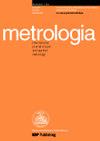用于 Kibble 平衡的挠性:尽量减少弹性松弛的影响
IF 2.4
3区 工程技术
Q2 INSTRUMENTS & INSTRUMENTATION
引用次数: 0
摘要
我们研究了在 Kibble 天平中使用的挠性器的非弹性后效应,挠性器在速度模式下受到较大偏移,然后进行高精度力比较。我们研究了恒定偏移和正弦偏移对力对比的影响。我们从理论和实验上探索了一种简单的擦除程序,即在给定的振幅和时间内将挠性体向相反方向弯曲。我们发现,擦除程序可将随时间变化的力降低约 30%。这项研究是通过一个分析模型进行的,并通过美国国家标准与技术研究院的新型 Kibble 天平进行实验验证,该天平采用沉淀硬化铜铍合金 C17200 制成的挠性件。我们通过实验测定了挠性件的模量缺陷,得出......。这一结果比以前的实验报告高出约 2 倍。此外,我们还发现在应力和应变状态发生变化后,挠曲器的内部平衡会发生静态偏移。这些静态偏移虽然可以测量,但很小,目前对我们的 Kibble 天平应用来说并不重要。在调查过程中,我们发现了一些神奇的挠性结构,它们的无弹性松弛非常小。在这些神奇的挠性结构中,通过在弯曲区域对具有非恒定截面的挠性结构进行适当塑形和加载,可以补偿导致无弹性松弛的机制。本文章由计算机程序翻译,如有差异,请以英文原文为准。
Flexures for Kibble balances: minimizing the effects of anelastic relaxation
We studied the anelastic aftereffect of a flexure being used in a Kibble balance, where the flexure is subjected to a large excursion in velocity mode after which a high-precision force comparison is performed. We investigated the effect of a constant and a sinusoidal excursion on the force comparison. We explored theoretically and experimentally a simple erasing procedure, i.e. bending the flexure in the opposite direction for a given amplitude and time. We found that the erasing procedure reduced the time-dependent force by about 30%. The investigation was performed with an analytical model and verified experimentally with our new Kibble balance at the National Institute of Standards and Technology employing flexures made from precipitation-hardened Copper Beryllium alloy C17200. Our experimental determination of the modulus defect of the flexure yields . This result is about a factor of two higher than previously reported from experiments. We additionally found a static shift of the flexure’s internal equilibrium after a change in the stress and strain state. These static shifts, although measurable, are small and deemed uncritical for our Kibble balance application at present. During this investigation, we discovered magic flexures that promise to have very little anelastic relaxation. In these magic flexures, the mechanism causing anelastic relaxation is compensated for by properly shaping and loading a flexure with a non-constant cross-section in the region of bending.
求助全文
通过发布文献求助,成功后即可免费获取论文全文。
去求助
来源期刊

Metrologia
工程技术-物理:应用
CiteScore
2.80
自引率
25.00%
发文量
137
审稿时长
12 months
期刊介绍:
Published 6 times per year, Metrologia covers the fundamentals of measurements, particularly those dealing with the seven base units of the International System of Units (metre, kilogram, second, ampere, kelvin, candela, mole) or proposals to replace them.
The journal also publishes papers that contribute to the solution of difficult measurement problems and improve the accuracy of derived units and constants that are of fundamental importance to physics.
In addition to regular papers, the journal publishes review articles, issues devoted to single topics of timely interest and occasional conference proceedings. Letters to the Editor and Short Communications (generally three pages or less) are also considered.
 求助内容:
求助内容: 应助结果提醒方式:
应助结果提醒方式:


